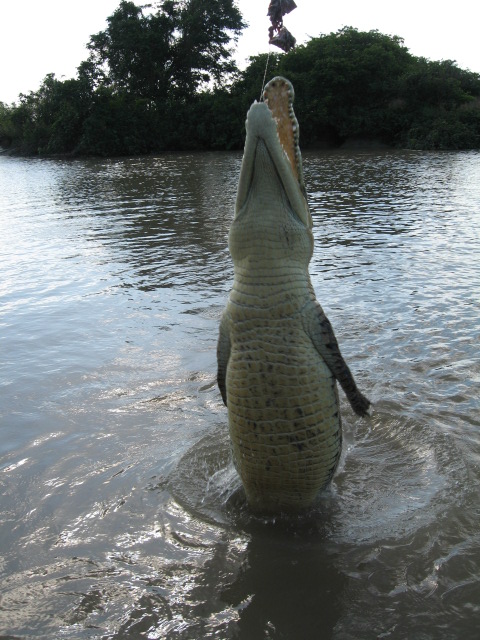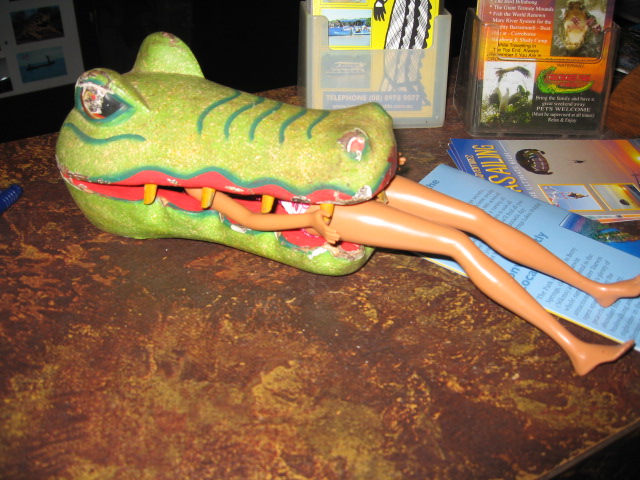


I have a longer entry for Sunday because I have a bunch of airplane time so a chance to write a bit more. So here are stories for the family back home!
When traveling to a town that is a tourist destination, one is always wary of “the tours.” You know, the tourist traps. Having local advice helps you steer towards the interesting experiences, particularly when you don’t have a lot of time. I had to work Sunday morning preparing from Monday, but we wanted to make sure and do something fun in the afternoon.
Melanie suggested that Sunday we either go to the wildlife park, or the jumping crocs cruise. While the lure of beautiful birds and cuddly marsupials was there, it seemed criminal not to see crocodiles while in the Northern Territory. So we booked into the Jumping Crocodile Cruise on the Adelaide River, about 90 km from Darwin. We caught a bus with only four others, driven by our guide, Rod, and headed up the highway. From the moment we pulled out, Rod was happy to share stories of the region, answer questions and, in his words, make things up when he didn’t know the answer. We sat up front and Rod and I kept a patter going the whole hour heading north out of town.
It was wonderful to pass out of the suburbs (which apparently are home to lots of military families, the military being the number one employer, followed by tourism, mines and oil production and some local farming.) At first we started smelling smoke and seeing haze in the air – one of the many bush fires that start during the “buildup” season between the “Dry” and the “Wet.” Lightening strikes that occur before the rains start to fall will start fires all over the region. In the natural state, the ecosystem relies on these fires to open fire triggered seeds, and clear undergrowth for new plants to start. As in the US, long term fire suppression has allowed more buildup of tinder causing fires to do more damage, plus there’s always that problem of people living where fires burn. Controlled “mosaic” burns are now used.
The other factor that cleans up the tinder are the termites, or, as one museum display called them, fixed position cows. Termites digest all the grasses as they dry, creating new soil, while their burrowing and mounding aerates the soil. Of the hundreds of termite species, only 2 eat people’s wooden homes.
We started seeing mango farms and I salivated, remembering my mango shake from the Parap market. Rod said (if memory serves) that there were 24 kinds of mangos under cultivation. We also passed banana farms and a dragon fruit farm. (LOOK UP URLS).
Our first stop was Fogg Dam reserve, the site of a massive rice paddy development in the post World War 2 era when the US left behind piles of heavy equipment and people decided to invent something to do with them. The Adelaide river flood plain was dammed to create paddies and a supply of water to irrigate during the dry season. The one tiny oversight was that the paddies and the dammed area were in flood plains that regularly saw meters of rainfall each year, effectively wiping out the dam and washing away the paddies. Plus the small amount of rice that was produced went to the docks in Darwin’s high humidity, swelled, split and became unsellable. Apparently Art Linkletter, the game show host, was one of the investors.
Today the dam’s legacy is the creation of a permanent wetlands, filled with birds, crocs, a wide range of marsupials, lizards and assorted critters. It is said to have one of the highest animal biomasses per square meter in the world, much of that in the form of small marsupials that eat the wild rice in the flood plains. The lotus flowers in the wetlands were just starting to blossom with pink sticking up amongst huge green lilly pads. We saw a lacy monitor, many kinds of birds, a few small lizards and wondered about the size of the crocs living in the water holes that stayed wet, even during the dry season. It was very beautiful.
Then, after a quick stop at “Window on the Wetlands” – a small government run museum and lookout on the wetlands created by the dam project and local highway berms, we finally headed through a water buffalo pasture to the verge of the Adelaide river, about 40km as the crow flies from the sea, and 90km as the river flows from the sea. The entire length of the river is about 180 km. Three more people joined our six, so as we were a small group, we were told we got to go in the small boat, a much more “up close” experience with the crocs. But first we got to hold Medusa, the water python, see local croc headlines pinned on the walls and have a cuppa. Then on to the river. “Keep your body parts in the boat!”
We were barely 100 feet out into the river amidst the cacophony of the white parrots on the shore trees when the first croc showed up, sensing the sound of the boat and the lure of bony chunks of water buffalo splashed into the water, strung on a pole. Cameras clicked and whirred as we tried to guess when and where the croc would jump. We didn’t have long to wait. Man those suckers are big. The sound of air forced out of fast closing jaws, the snap of yellow, white and even orange tinged teeth, the smooth belly glistening as the animal propels itself vertically out of the water with it’s tail. Quite magnificent. And sobering. No wonder people don’t swim in the rivers, ponds, lakes and oceans here. These opportunistic carnivores would have you as a snack.
We cruised down the river, stopping when a croc was spotted to feed them. They varied in color and size. The older, big males were HUGE. We took a ton of pictures, some of which I have loaded up on to flickr. Then they fed the scraps to local birds of prey who swooped to give us a final show before we headed back upriver to the dock.
On the way back, more story swapping with Rod, who also kindly dropped us at the Mindle Beach Sunday Night Market, where we gorged on more fruit smoothies, shopped for presents to bring home and sampled food from the row of vendors. We had octopus skewers, honey chicken, salt and pepper squid, and my favorite, an Indonesian lamb satay from a Hallal vendor. As Larry and I gorged on the satay, the vendor asked if we were enjoying it. As if. We were oohing and ahing as we slurped the last bits of peanut sauce on the sticky rice cakes hidden beneath the satay. He then asked where we were from and when he heard we were from out of town, he offered us a plate of gado gado (I think… I may be remembering the name wrong and I’m sad I already forgot his name and his wife and niece, who were working with him) to try. His gift. It too, was wonderful, but even more wonderful was his hospitality. I watched him as he interacted with his other customers, most who seemed to know him by name and he them. His genuine greeting. His attention to how he prepared each person’s order, was a beautiful thing. It was a pleasure watching him work because his love for his work was shining there.
Finally, we got a shared mini bus back to the hotel. And I went back to work, preparing for Monday’s presentations.


No comments:
Post a Comment